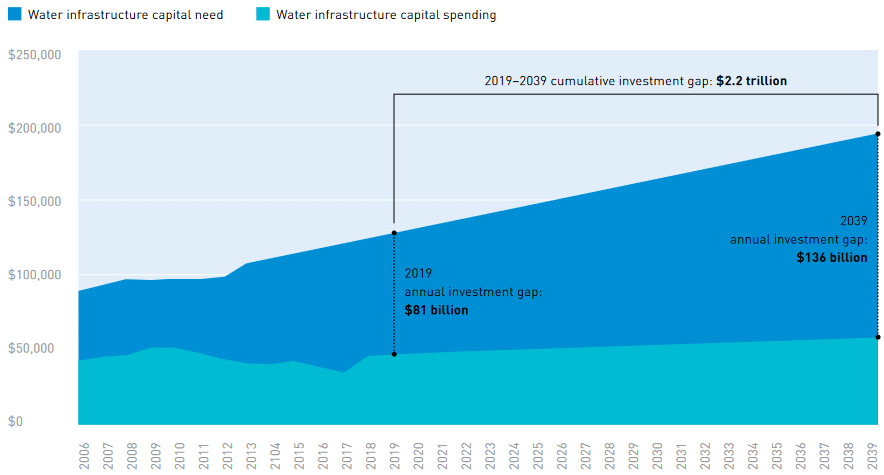Both nationally and internationally, many assume that residents of the United States live with universal access to drinking water and sanitation. However, according to data from the American Community Survey and the Environmental Protection Agency (EPA), 489,836 US households lack complete plumbing; 1,165 community water systems are in serious violation of the Safe Drinking Water Act (SDWA); and 21,035 Clean Water Act (CWA) permittees are in significant noncompliance.
Technical and financial assessments from professional organizations reflect this inequitable access to potable water and sanitation. The American Society of Civil Engineers (ASCE) graded the United States a “C–” for drinking water infrastructure, a “D+” for wastewater infrastructure, and a “D” for stormwater infrastructure. Additionally, according to a 2020 report by the US Water Alliance, the annual investment gap between water infrastructure capital needs and capital spending in 2019 amounted to $81 billion.
The ratification of the Bipartisan Infrastructure Law (BIL) presents a unique opportunity to address these drinking water and wastewater inequities by investing $43 billion through the Clean Water and Drinking Water State Revolving Funds (SRF). These investments will provide grants and low-to-no interest loans to disadvantaged and underserved communities for water infrastructure projects.
The US EPA has historically supported communities by providing Technical Assistance (TA) programs to identify infrastructure needs, address compliance issues, apply for funding sources, and build technical, managerial, and financial capacity.
Currently, with the availability of BIL funding, the EPA is collaborating with two of its Environmental Finance Centers—the University of North Carolina, Chapel Hill; and California State University, Sacramento (Sacramento State)—to launch a new technical assistance initiative called the H2O Community Solutions Teams. The initiative aims to bring together technical experts and community outreach specialists to provide focused technical assistance to disadvantaged and underserved communities to prepare for and access BIL funding for drinking water and wastewater infrastructure projects.
The H2O Community Solutions Teams will assist communities in applying for SRF through the following steps:
- Conduct a preliminary assessment—The H2O Community Solution Teams will meet and engage with local water agencies and water systems, local and state government officials, and the EPA to build a profile of the community and preliminarily assess its water infrastructure and technical, managerial, and financial (TMF) capacities.
- Perform a needs assessment—The H2O Community Solutions Teams will carry out a systematic process to determine gaps and deficiencies in a community’s drinking water/wastewater system and its TMF capacity. In this phase, the Teams will perform the following:
- Gather evidence—Conduct system site visits; conduct environmental justice, cultural, and historical assessments; listen directly to utilities about their needs; and request background documentation and information.
- Analyze evidence and determine gaps and deficiencies—Develop a detailed game plan informed primarily by the system site visit findings and feedback summaries from the outreach efforts with the relevant stakeholders (i.e., water systems, local and state agencies).
- Determine next steps for improvement—Hold an internal meeting to review, refine, and finalize the detailed game plan’s conclusions and recommendations.
- Develop a technical assistance work plan—The H2O Community Solutions Teams will develop a system-tailored technical assistance work plan aimed at developing an SRF application to access funding for a drinking water/wastewater system infrastructure project. In this project phase, the Teams will achieve the following steps:
- Identify a list of appropriate technical solutions
- Develop prioritization criteria to rank the appropriate technical solutions
- Draft and distribute a final work plan for implementation
- Implement the technical assistance work plan—The Teams will determine which work plan tasks and objectives can be achieved during the H2O Community Solutions Teams initiative’s pilot phase. Once determined, the team will hold a work plan implementation kick-off meeting, administer the work plan task implementation, and draft and publish a final project report.

Steps involved in the preliminary assessment and needs assessment phases of the H2O community solutions teams workflow.
According to estimates, approximately 2.5 percent (596 counties) of community water systems are listed as significantly violating the SDWA, and 6 percent (2178 counties) of permittees are listed as significantly violating the CWA. These statistics indicate that millions in the population are facing hardship from and exposure to poor water quality. As the single largest federal investment ($50 billion) in the water sector, BIL funding is both historic and transformational in its scope and effects in strengthening the nation’s drinking water and wastewater systems. BIL funding is a bridge toward equitable access to clean drinking water and sanitation.
If you are interested in learning more about the H2O Community Solutions Teams and gaining access to BIL funding—or accessing any of the cutting-edge resources, hands-on training, and free professional services that the Environmental Finance Center Network (EFCN) provides—you can get in touch with us by filling out an EFCN Request for Assistance form.


